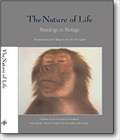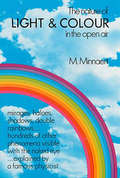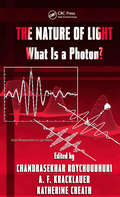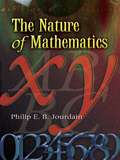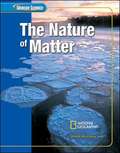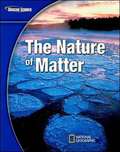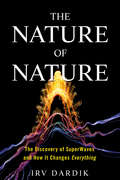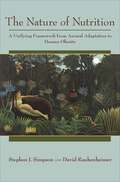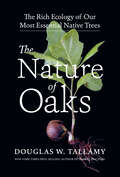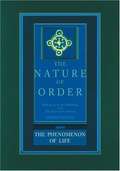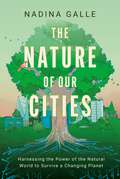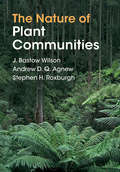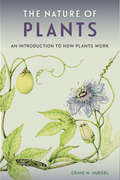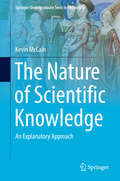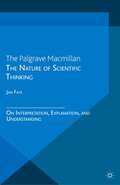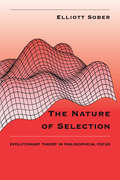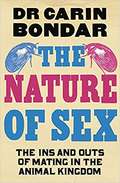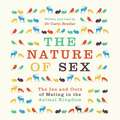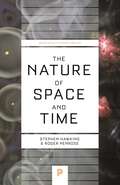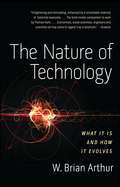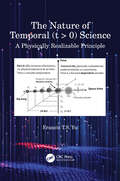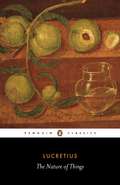- Table View
- List View
The Nature of Life: Readings in Biology
by Joseph Coulson Donald Whitfield Mike Levine Nancy Carr Gary Schoepfel Mark StefanskiHow did life begin? How is it changing? How do we understand our place in the world in relation to other living beings? The Nature of Life: Readings in Biology encourages inquiry-based discussion of scientific writings that attempt to answer universal questions about the nature of life. The anthology includes 19 selections written by major scientists and questions designed to spark lively shared inquiry discussion. This anthology is ideal for students and adult readers interested in developing a deeper understanding of the life sciences. Selections from: Aristotle, Francis Bacon, Claude Bernard, Rachel Carson, Paul Colinvaux, Charles Darwin, Richard Dawkins, Loren Eiseley, Stephen Jay Gould, Konrad Lorenz, Lucretius, Lynn Margulis, Gregor Mendel, James D. Watson, and Edward O. Wilson.
The Nature of Light and Colour in the Open Air
by M. MinnaertRainbows, mirages, multiple moons, black snow, colored shadows, irridescent clouds, halos, green surf, and hundreds of other natural phenomena are clearly and simply explained in this unique book by Professor Minnaert of the University of Utrecht. Written with complete lucidity, it is a book not only for astronomers, physicists, and geographers, but also for artists and photographers and for anyone else who would like to know more about how to observe and understand the strange behavior of light and color in nature.The author shows just how, when, and under what conditions to observe the fata morgana (a complex mirage in the form of a city in the sky), the scintillation of stars and planets, apparent motion in shadows and objects due to air currents, color changes due to refraction and reflection, illusions of motion and direction, effects of rapidly moving spokes, the changes in color and light due to eclipses of the sun and moon, magnificent colors on a frozen window pane, or an extended body of water, the deceptive appearance of objects beneath the surface of water, and many other such phenomena.The theory explaining most of these effects is given in ordinary language only occasionally supplemented by elementary mathematical demonstrations. In addition, Professor Minnaert has included 202 illustrations (including 42 photographs) covering practically every phenomenon discussed. These illustrations make hundreds of details explicit so that you can identify them at sight and try the experiments outlined.
The Nature of Light: What is a Photon? (Optical Science and Engineering)
by AntonioFocusing on the unresolved debate between Newton and Huygens from 300 years ago, The Nature of Light: What is a Photon? discusses the reality behind enigmatic photons. It explores the fundamental issues pertaining to light that still exist today. Gathering contributions from globally recognized specialists in electrodynamics and quantum optics, the book begins by clearly presenting the mainstream view of the nature of light and photons. It then provides a new and challenging scientific epistemology that explains how to overcome the prevailing paradoxes and confusions arising from the accepted definition of a photon as a monochromatic Fourier mode of the vacuum. The book concludes with an array of experiments that demonstrate the innovative thinking needed to examine the wave-particle duality of photons. Looking at photons from both mainstream and out-of-box viewpoints, this volume is sure to inspire the next generation of quantum optics scientists and engineers to go beyond the Copenhagen interpretation and formulate new conceptual ideas about light–matter interactions and substantiate them through inventive applications.
The Nature of Mathematics
by Philip E. JourdainAnyone with an interest in mathematics will welcome the republication of this little volume by a remarkable mathematician who was also a logician, a philosopher, and an occasional writer of fiction and poetry. Originally published in 1913, and later included in the acclaimed anthology The World of Mathematics, Jourdain's survey shows how and why the methods of mathematics were developed, traces the development of mathematical science from the earliest to modern times, and chronicles the application of mathematics to natural science.Starting with the ancient Egyptians and Greeks, the author profiles mathematics' rise and progress with the development of analytical methods by Descartes, Galileo, Newton, Leibnitz, and others. The text focuses on principles rather than techniques, exploring the foundations of algebra, analytical geometry, and the method of indivisibles. It discusses the beginnings of the correlation of mathematics and natural science in the study of dynamics as well as the emergence of modern mathematics with the infinitesimal calculus. Additional topics include contemporary views of limits and numbers and a brief summation of the nature of mathematics.
The Nature of Matter
by Glencoe McGraw-Hill StaffDiscover the flexibility to teach science your way. "The Nature of Matter," as a part of the Glencoe Science 15-Book Series, provides students with accurate and comprehensive coverage of matter and its properties, including the Periodic Table. The strong content coverage integrates a wide range of hands-on experiences, critical-thinking opportunities, and real-world applications. The modular approach allows you to mix and match books to meet your curricula.
The Nature of Motive Force
by Achintya Kumar PramanickIn this monograph Prof. Pramanick explicates the law of motive force, a fundamental law of nature that can be observed and appreciated as an addition to the existing laws of thermodynamics. This unmistakable and remarkable tendency of nature is equally applicable to all other branches of studies. He first conceptualized the law of motive force in 1989, when he was an undergraduate student. Here he reports various applications of the law in the area of thermodynamics, heat transfer, fluid mechanics and solid mechanics, and shows how it is possible to solve analytically century-old unsolved problems through its application. This book offers a comprehensive account of the law and its relation to other laws and principles, such as the generalized conservation principle, variational formulation, Fermat's principle, Bejan's constructal law, entropy generation minimization, Bejan's method of intersecting asymptotes and equipartition principle. Furthermore, the author addresses some interrelated fundamental problems of contemporary interest, especially to thermodynamicists, by combining analytical methods, physical reasoning and the proposed law of motive force. This foundational work is a valuable reading for both students and researchers in exact as well as non-exact sciences and, at the same time, a pleasant learning experience for the novice.
The Nature of Nature: The Discovery of SuperWaves and How It Changes Everything
by Irving Dardik Estee Dardik LichterWhat is everything made of? How do things change and how do they work? What is life? In The Nature of Nature, visionary scientist Irv Dardik tackles these questions by introducing his discovery of SuperWaves, a singular wave phenomenon whose design generates what we experience as matter, space, time, motion, energy, and order and chaos. Simply put, the SuperWaves principle states that the fundamental stuff of nature is waves—waves waving within waves, to be exact. Dardik challenges the rationality of accepting a priori that the universe is made of discrete particles. Instead, by drawing from his own discovery of a unique wave behavior and combining it with scientific facts, he shows that every single thing in existence—from quantum particles to entire galaxies—is waves waving in the unique pattern he calls SuperWaves. The discovery of SuperWaves and the ideas behind it, while profound, can be intuitively grasped by every reader, whether scientist or layperson. Touching on everything from quantum physics to gravity, to emergent complexity and thermodynamics, to the origins of health and disease, it shows that our health, and the health of the environment and civilization, depend upon our understanding SuperWaves. The Nature of Nature is an absorbing account that combines Dardik’s contrarian look at the history of science with philosophical discussion, his own groundbreaking research, and hope for the future.
The Nature of Nutrition: A Unifying Framework from Animal Adaptation to Human Obesity
by David Raubenheimer Stephen J. SimpsonThe first book to address nutrition's complex role in biologyNutrition has long been considered more the domain of medicine and agriculture than of the biological sciences, yet it touches and shapes all aspects of the natural world. The need for nutrients determines whether wild animals thrive, how populations evolve and decline, and how ecological communities are structured. The Nature of Nutrition is the first book to address nutrition's enormously complex role in biology, both at the level of individual organisms and in their broader ecological interactions.Stephen Simpson and David Raubenheimer provide a comprehensive theoretical approach to the analysis of nutrition—the Geometric Framework. They show how it can help us to understand the links between nutrition and the biology of individual animals, including the physiological mechanisms that determine the nutritional interactions of the animal with its environment, and the consequences of these interactions in terms of health, immune responses, and lifespan. Simpson and Raubenheimer explain how these effects translate into the collective behavior of groups and societies, and in turn influence food webs and the structure of ecosystems. Then they demonstrate how the Geometric Framework can be used to tackle issues in applied nutrition, such as the problem of optimizing diets for livestock and endangered species, and how it can also help to address the epidemic of human obesity and metabolic disease.Drawing on a wealth of examples from slime molds to humans, The Nature of Nutrition has important applications in ecology, evolution, and physiology, and offers promising solutions for human health, conservation, and agriculture.
The Nature of Oaks: The Rich Ecology of Our Most Essential Native Trees
by Douglas W. Tallamy&“A timely and much needed call to plant, protect, and delight in these diverse, life-giving giants.&” —David George Haskell, author of The Forest Unseen and The Songs of Trees With Bringing Nature Home, Doug Tallamy changed the conversation about gardening in America. His second book, the New York Times bestseller Nature&’s Best Hope, urged homeowners to take conservation into their own hands. Now, he is turning his advocacy to one of the most important species of the plant kingdom—the mighty oak tree. Oaks sustain a complex and fascinating web of wildlife. The Nature of Oaks reveals what is going on in oak trees month by month, highlighting the seasonal cycles of life, death, and renewal. From woodpeckers who collect and store hundreds of acorns for sustenance to the beauty of jewel caterpillars, Tallamy illuminates and celebrates the wonders that occur right in our own backyards. He also shares practical advice about how to plant and care for an oak, along with information about the best oak species for your area. The Nature of Oaks will inspire you to treasure these trees and to act to nurture and protect them.
The Nature of Order, An Essay on the Art of Building and the Nature of the Universe: Volume 1, The Phenomenon of Life
by Christopher AlexanderWhat is happening when a place in the world has life? And what is happening when it does not? In Book 1 of this four-volume work, Alexander describes a scientific view of the world in which all space-matter has perceptible degrees of life, and sets this understanding of living structure as an intellectual basis for a new architecture. He identifies fifteen geometric properties which tend to accompany the presence of life in nature, and also in the buildings and cities we make. These properties are seen over and over in nature, and in cities and streets of the past, but have all but disappeared in the deadly developments and buildings of the last one hundred years. The book shows that living structure depends on features which make a close connection with the human self, and that only living structure has the capacity to support human well-being. The other three volumes of The Nature of Order continue this thesis with three complementary views giving a masterful prescription for the processes which allow us to generate living structure in the world. They show us what such a world must gradually come to look like, and describe the modified cosmology in which "life" as an essential quality, together with our inner connection to the world around us-towns, streets, buildings, and artifacts-are central to a proper understanding of the scientific nature of the universe. "... Five hundred years is a long time, and I don't expect many of the people I interview will be known in the year 2500. Christopher Alexander may be an exception."--David Creelman, author, interviewer and editor, HR Magazine, Toronto. Christopher Alexander is a fellow of the American Academy of Arts and Sciences, architect, builder and author of many books and technical papers. He is the winner of the first medal for research ever awarded by the American Institute of Architects, and after 40 years of teaching is Professor Emeritus at the University of California, Berkeley.
The Nature of Our Cities: Harnessing the Power of the Natural World to Survive a Changing Planet
by Nadina GalleIn the tradition of Elizabeth Kolbert and Michael Pollan, The Nature of Our Cities is a stirring exploration of how innovators from around the world are combining urban nature with emerging technologies, protecting the planet’s cities from the effects of climate change and safeguarding the health of their inhabitants.We live in an age when humanity spends 90% of its time indoors, yet the nature around us—especially in America’s cities—has never been more vital. This distancing from nature has sparked crises in mental health, longevity, and hope for the next generation, while also heightening the risks we face from historic floods, heatwaves, and wildfires. Indeed, embracing nature holds untapped potential to strengthen and fortify our cities, suburbs, and towns, providing solutions spanning flood preparation, wildfire management, and promoting longevity. As ecological engineer Dr. Nadina Galle shows in The Nature of Our Cities nature is our most critical infrastructure for tackling the climate crisis. It just needs a little help. A fellow at MIT’s Senseable City Lab and selected for Forbes’ 30 under 30 list, Galle is at the forefront of the growing movement to fuse nature and technology for urban resilience. In THE NATURE OF OUR CITIES, she embarks on a journey as fascinating as it is pressing, showing how scientists and citizens from around the world are harnessing emerging technologies to unlock the power of the natural world to save their cities, a phenomenon she calls the “Internet of Nature.” Traveling the globe, Galle examines how urban nature, long an afterthought for many, actually points the way toward a more sustainable future. She reveals how technology can help nature navigate this precarious moment with modern advances such as:Laser-mapping that identifies at-risk neighborhoods to fight deadly health disparitiesA.I.-powered robots that prevent wildfires from reaching urban areasIntelligent water gardens that protect cities from floods and hurricanesAdvanced sensors that achieve 99% tree survival in dry, hot summers Optimistic in spirit yet pragmatic in approach, Galle writes persuasively that the future of urban life depends on balancing the natural world with the technology that can help sustain it. By turns clear-eyed and lyrical, THE NATURE OF OUR CITIES marks the emergence of an invigorating, prescient new talent in nature writing.
The Nature of Plant Communities
by J. Bastow Wilson Andrew D. Agnew Stephen H. RoxburghMost people can readily identify a forest, or a grassland, or a wetland - these are the simple labels we give different plant communities. The aim of this book is to move beyond these simple descriptions to investigate the 'hidden' structure of vegetation, asking questions such as how do species in a community persist over time? What prevents the strongest species from taking over? And, are there rules that confer stability and produce repeatable patterns? Answers to these questions are fundamental to community ecology, and for the successful management of the world's varied ecosystems, many of which are currently under threat. In addition to reviewing and synthesising our current knowledge of species interactions and community assembly, this book also seeks to offer a different viewpoint - to challenge the reader, and to stimulate ecologists to think differently about plant communities and the processes that shape them.
The Nature of Plants: An Introduction to How Plants Work
by Craig N. HuegelChoice Outstanding Academic Title Florida Book Awards, Bronze Medal for General Nonfiction Plants play a critical role in how we experience our environment. They create calming green spaces, provide oxygen for us to breathe, and nourish our senses. In The Nature of Plants, ecologist and nursery owner Craig Huegel demystifies the complex lives of plants and provides readers with an extensive tour into their workings. Beginning with the importance of light, water, and soil, Huegel describes the process of photosynthesis and how best to position plants to receive optimal sunlight. He explains why plants suffer from overwatering, what essential elements plants need to flourish, and what important soil organisms reside with them. Readers will understand the difference between friendly and hostile bacteria, fungi, and insects. Sections on plant structure and reproduction focus in detail on major plant organs—roots, stems, and leaves—and cover flowering, pollination, fruit development, and seed germination. Huegel even delves into the mysterious world of plant communication, exploring the messages conveyed to animals or other plants through chemical scents and hormones. With color illustrations, photographs, and real-life examples from his own gardening experiences, Huegel equips budding botanists, ecologists, and even the most novice gardeners with knowledge that will help them understand and foster plants of all types.
The Nature of Scientific Knowledge
by Kevin MccainThis book offers a comprehensive and accessible introduction to the epistemology of science. It not only introduces readers to the general epistemological discussion of the nature of knowledge, but also provides key insights into the particular nuances of scientific knowledge. No prior knowledge of philosophy or science is assumed by The Nature of Scientific Knowledge. Nevertheless, the reader is taken on a journey through several core concepts of epistemology and philosophy of science that not only explores the characteristics of the scientific knowledge of individuals but also the way that the development of scientific knowledge is a particularly social endeavor. The topics covered in this book are of keen interest to students of epistemology and philosophy of science as well as science educators interested in the nature of scientific knowledge. In fact, as a result of its clear and engaging approach to understanding scientific knowledge The Nature of Scientific Knowledge is a book that anyone interested in scientific knowledge, knowledge in general, and any of a myriad of related concepts would be well advised to study closely.
The Nature of Scientific Thinking
by Jan FayeScientific thinking must be understood as an activity. The acts of interpretation, representation, and explanation are the cognitive processes by which scientific thinking leads to understanding. The book explores the nature of these processes and describes how scientific thinking can only be grasped from a pragmatic perspective.
The Nature of Selection: Evolutionary Theory in Philosophical Focus
by Elliott SoberThe Nature of Selection is a straightforward, self-contained introduction to philosophical and biological problems in evolutionary theory. It presents a powerful analysis of the evolutionary concepts of natural selection, fitness, and adaptation and clarifies controversial issues concerning altruism, group selection, and the idea that organisms are survival machines built for the good of the genes that inhabit them. "Sober's is the answering philosophical voice, the voice of a first-rate philosopher and a knowledgeable student of contemporary evolutionary theory. His book merits broad attention among both communities. It should also inspire others to continue the conversation. "-Philip Kitcher, Nature "Elliott Sober has made extraordinarily important contributions to our understanding of biological problems in evolutionary biology and causality. The Nature of Selection is a major contribution to understanding epistemological problems in evolutionary theory. I predict that it will have a long lasting place in the literature. "-Richard C. Lewontin
The Nature of Selection: Evolutionary Theory in Philosophical Focus
by Elliott SoberThe Nature of Selection is a straightforward, self-contained introduction to philosophical and biological problems in evolutionary theory. It presents a powerful analysis of the evolutionary concepts of natural selection, fitness, and adaptation and clarifies controversial issues concerning altruism, group selection, and the idea that organisms are survival machines built for the good of the genes that inhabit them. "Sober's is the answering philosophical voice, the voice of a first-rate philosopher and a knowledgeable student of contemporary evolutionary theory. His book merits broad attention among both communities. It should also inspire others to continue the conversation."-Philip Kitcher, Nature "Elliott Sober has made extraordinarily important contributions to our understanding of biological problems in evolutionary biology and causality. The Nature of Selection is a major contribution to understanding epistemological problems in evolutionary theory. I predict that it will have a long lasting place in the literature."-Richard C. Lewontin
The Nature of Sex: The Ins and Outs of Mating in the Animal Kingdom
by Carin BondarThought about sex today? Of course you have! It's about the most natural thing any animal can do. But have you ever wondered how human sex compares to that of other beasts? It's far from merely inserting part A into slot B. The sex lives of our animal cousins are fiendishly difficult, infinitely varied and often violent. They involve razor-sharp penises, murderous cannibals and chemical warfare in an epic battle between the sexes.Join renowned biologist Dr Carin Bondar on a fascinating journey from puberty to old age across the entire animal kingdom - it will forever change your idle daydreams about the nature of sex.
The Nature of Sex: The Ins and Outs of Mating in the Animal Kingdom
by Dr Carin BondarThought about sex today? Of course you have! It's about the most natural thing any animal can do. But have you ever wondered how human sex compares to that of other beasts? It's far from merely inserting part A into slot B. The sex lives of our animal cousins are fiendishly difficult, infinitely varied and often violent. They involve razor-sharp penises, murderous cannibals and chemical warfare in an epic battle between the sexes.Join renowned biologist Dr Carin Bondar on a fascinating journey from puberty to old age across the entire animal kingdom - it will forever change your idle daydreams about the nature of sex.
The Nature of Sex: The Ins and Outs of Mating in the Animal Kingdom
by Dr Carin BondarNarrated by the author.Thought about sex today? Of course you have! It's about the most natural thing any animal can do. But have you ever wondered how human sex compares to that of other beasts? It's far from merely inserting part A into slot B. The sex lives of our animal cousins are fiendishly difficult, infinitely varied and often violent. They involve razor sharp penises, murderous cannibals and chemical warfare in an epic battle between the sexes.Like us, animals must first find the perfect partner. You think we have it tough? Try having to do it while being hunted down by predators, against a backdrop of unpredictable or life-threatening conditions. Then, sperm and egg must successfully meet. Can you imagine doing this when your partner is intent on killing you or when other disgruntled singles are determined to throw you off your game? The next task is to ensure that the resultant offspring reach sexual maturity in order to keep the cycle going. The myriad ways in which this is accomplished is ingenious.Join Carin Bondar on a fascinating journey from puberty to old age across the entire animal kingdom - it will forever change your idle daydreams about the nature of sex.(p) 2015 Orion Publishing Group
The Nature of Space and Time (Princeton Science Library #40)
by Roger Penrose Stephen HawkingFrom two of the world's great physicists—Stephen Hawking and Nobel laureate Roger Penrose—a lively debate about the nature of space and timeEinstein said that the most incomprehensible thing about the universe is that it is comprehensible. But was he right? Can the quantum theory of fields and Einstein's general theory of relativity, the two most accurate and successful theories in all of physics, be united into a single quantum theory of gravity? Can quantum and cosmos ever be combined? In The Nature of Space and Time, two of the world’s most famous physicists—Stephen Hawking (A Brief History of Time) and Roger Penrose (The Road to Reality)—debate these questions.The authors outline how their positions have further diverged on a number of key issues, including the spatial geometry of the universe, inflationary versus cyclic theories of the cosmos, and the black-hole information-loss paradox. Though much progress has been made, Hawking and Penrose stress that physicists still have further to go in their quest for a quantum theory of gravity.
The Nature of Technology: What It Is and How It Evolves
by W. Brian Arthur“More than anything else technology creates our world. It creates our wealth, our economy, our very way of being,” says W. Brian Arthur. Yet despite technology’s irrefutable importance in our daily lives, until now its major questions have gone unanswered. Where do new technologies come from? What constitutes innovation, and how is it achieved? Does technology, like biological life, evolve? In this groundbreaking work, pioneering technology thinker and economist W. Brian Arthur answers these questions and more, setting forth a boldly original way of thinking about technology. The Nature of Technology is an elegant and powerful theory of technology’s origins and evolution. Achieving for the development of technology what Thomas Kuhn’s The Structure of Scientific Revolutions did for scientific progress, Arthur explains how transformative new technologies arise and how innovation really works. Drawing on a wealth of examples, from historical inventions to the high-tech wonders of today, Arthur takes us on a mind-opening journey that will change the way we think about technology and how it structures our lives. The Nature of Technology is a classic for our times.
The Nature of Temporal (t > 0) Science: A Physically Realizable Principle
by Francis T.S. YuThe author has shown that practically all our laws, principles, and theories are not physically realizable, since they were derived from an empty space paradigm. From which this book is started with the origin of our temporal (t > 0) universe, it shows that temporal subspace is a physically realizable space within our universe. As in contrasted with generally accepted paradigm where time is an independent variable. From which the author has shown that it is not how rigorous mathematics is, but it is the temporal (t > 0) space paradigm determines the physically realizable solution. Although Einstein’s relativity and Schrödinger's principle had revolutionized the modern science, this book has shown that both theory and principle are physically non-realizable since they were developed from an empty space paradigm. One of the most important contribution of this book must be the revolutionary idea of our temporal (t > 0) space, for which the author has shown that absolute certainty exists only at the present (t = 0) moment. Where past-time information has no physical substance and future-time represents a physically realizable yet uncertainty. From which the author has shown that all the existent laws, principles, and theories were based on past-time certainties to predict the future, but science is supposed to be approximated. The author has also shown that this is precisely our theoretical science was developed. But time independent laws and principles are not existed within our temporal universe, in view of the author’s temporal exclusive principle. By which the author has noted that timeless science has already created a worldwide conspiracy for examples such as superposition principle, qubit information, relativity theory, wormhole travelling and many others. This book has also shown that Heisenberg’s uncertainty is an observational principle independent with time, yet within our universe everything changes with time. In this book the author has also noted that micro space behaviors the same as macro space regardless of the particle size. Finally, one of interesting feature is that, that big bang creation was ignited by a self-induced gravitational force instead by time as commonly believed. Nevertheless, everything has a price to pay; a section of time ∆t and an amount of energy ∆E and it is not free. The author has also shown that time is the only variable that cannot be changed. Although we can squeeze a section of time ∆t as small as we wish but we can never able to squeeze ∆t to zero even we have all the needed energy. Nevertheless, this revolutionary book closer to the truth is highly recommended to every scientist and engineer, otherwise we will forever be trapped within the timeless fantasyland of science. This book is intended for cosmologists, particle physicists, astrophysicists, quantum physicists, computer scientists, optical scientists, communication engineers, professors, and students as a reference or a research-oriented book.
The Nature of Things
by LucretiusLucretius' poem On the Nature of Things combines a scientific and philosophical treatise with some of the greatest poetry ever written. With intense moral fervour he demonstrates to humanity that in death there is nothing to fear since the soul is mortal, and the world and everything in it is governed by the mechanical laws of nature and not by gods; and that by believing this men can live in peace of mind and happiness. He bases this on the atomic theory expounded by the Greek philosopher Epicurus, and continues with an examination of sensation, sex, cosmology, meteorology, and geology, all of these subjects made more attractive by the poetry with which he illustrates them.
